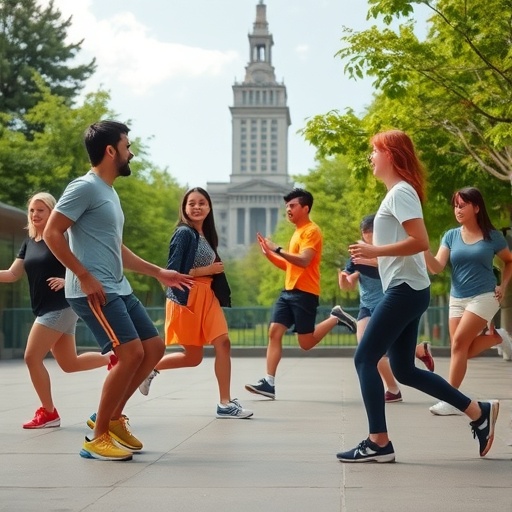In the ever-evolving landscape of education, new paradigms are emerging that merge technology, psychology, and human physicality to enrich the learning experience. A groundbreaking study conducted by de Koning, Zhang, and Sepp examines the critical role of human movement in enhancing language instruction through multimedia tools and theoretical frameworks. This research stands out not only for its innovative approach but also for its implications on how educators can adapt to better serve diverse learning styles.
The central thesis of the study posits that integrating bodily movements into instructional designs significantly boosts cognitive retention and engagement among language learners. By incorporating actions, gestures, and physical activities, educators can foster an immersive learning environment that capitalizes on the embodied cognition theory. This theory suggests that our understanding of the world is heavily influenced by our bodily interactions with it, making movement an essential element in the language acquisition process.
At the heart of this research lies the concept of multimodal learning, which advocates for the use of multiple sensory modalities to facilitate understanding and retention. The authors argue that traditional teaching methods, often rooted in a static, one-dimensional framework, fail to accommodate the dynamic nature of human cognition. Illustrating this point, the researchers provide empirical evidence supporting the complex interrelations between movement and learning outcomes, highlighting that students exposed to kinesthetic learning activities exhibit enhanced vocabulary retention compared to those engaged in purely auditory or visual exercises.
One of the paramount findings of the study is that movements associated with language—such as gestures that embody specific meanings—can serve as powerful mnemonic devices. For instance, when learners enact verbs through physical movements, they create a connection between the abstract concept of the word and their sensory experiences. This embodied learning method not only aids memory but also cultivates a deeper emotional connection to the material, thereby enriching the educational experience holistically.
Moreover, the research emphasizes the necessity of developing multimedia resources that incorporate movement as a structural element rather than a mere supplement. Traditional educational videos, avatars in language apps, and virtual environments can all be optimized with motion-based interaction. Educators are encouraged to seek or develop platforms that facilitate such engagement, expanding the boundaries of how and where students can interact with language.
The study also emphasizes the necessity of teacher training in this new educational paradigm. As the intricacies of learning through movement and multimedia become clearer, educators must undergo training that equips them with the skills to implement these strategies effectively. The authors highlight innovative professional development programs aimed at fostering a community of practice among educators where experiences can be shared, and strategies honed.
Furthermore, the implications of this research extend beyond the classroom. In our rapidly digitizing world, language communication patterns are also changing. Social media, online gaming, and interactive applications increasingly necessitate new forms of language usage. As a result, incorporating movement into these online platforms not only supports traditional learners but also aligns with the preferences of digital natives who thrive in interactive, engaging environments.
The authors also reference technological advancements, such as virtual reality (VR) and augmented reality (AR), that could revolutionize language instruction. These technologies offer unprecedented opportunities for immersive learning experiences that transcend traditional barriers. Imagine a language learner stepping into a virtual marketplace where they must negotiate and transact with avatars in the target language, using their physical movements to navigate their interaction. This type of gamified experience promises to not only enhance language skills but also build confidence and fluency.
In analyzing the broader educational landscape, de Koning, Zhang, and Sepp argue that educational institutions must adapt quickly to embrace these transformative methodologies. As competitive pressures mount to prepare students for a global economy that demands more than rote memorization, the ability to apply language in real-world scenarios while engaging physically becomes paramount. The authors challenge educators and policy-makers alike to rethink curriculum designs that exclusively focus on cognitive-based approaches devoid of physical interaction.
Additionally, societal factors influence the effectiveness of movement in learning. Different cultures approach education in unique ways, often emphasizing cooperative learning, communal movement, and interactive methods. By incorporating movement, educators can create a culturally responsive classroom that respects diverse learning preferences and promotes inclusivity.
The initial findings of this research invite further inquiry into other disciplines as well. The interdisciplinary nature of movement-based learning unlocks potential across various fields, including mathematics, science, and the arts. By positioning movement as a central component, the authors suggest that educational frameworks can become more holistic, enhancing learner engagement and creativity across the board.
Ultimately, de Koning, Zhang, and Sepp’s research is a clarion call for a revolution in educational practices. By marrying physical movement with modern multimedia technologies and theories of cognition, a new blueprint emerges for effective language instruction. As educators begin integrating these findings into their frameworks, the potential for transformative classroom experiences is boundless.
A shift towards encompassing movement as a vital element of learning not only caters to diverse learning styles but also enhances overall academic success. This study is a testament to the power of interdisciplinary research and its ability to challenge conventional wisdom and push the boundaries of educational effectiveness.
As we move forward in implementing these groundbreaking strategies, the ultimate goal is to cultivate learners who are not only proficient in language but also poised to thrive in an interconnected world where communication transcends mere words. Unlocking the synergy between movement, multimedia, and cognitive science could very well redefine the future of language education.
Subject of Research: The integration of human movement in language learning through multimedia and theoretical frameworks.
Article Title: Integrating Human Movement in Learning: Advancements in Language Instruction, Multimedia, and Theory.
Article References:
de Koning, B., Zhang, S. & Sepp, S. Integrating Human Movement in Learning: Advancements in Language Instruction, Multimedia, and Theory.
Educ Psychol Rev 37, 51 (2025). https://doi.org/10.1007/s10648-025-10027-1
Image Credits: AI Generated
DOI: 10.1007/s10648-025-10027-1
Keywords: human movement, language instruction, multimedia learning, embodied cognition, kinesthetic learning, teacher training, virtual reality, augmented reality, cognitive psychology, interdisciplinary education.




